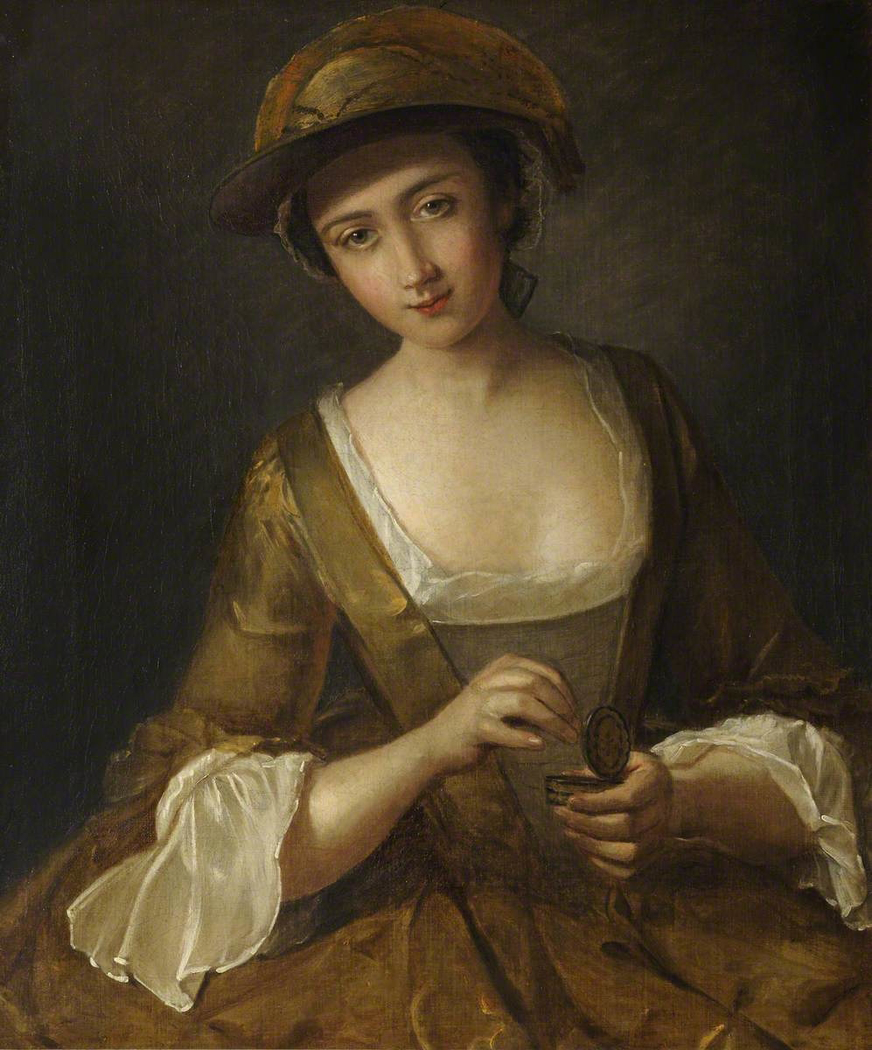Citation
Chicago:
Aimee Marcereau DeGalan, “John Smart, Portrait of a Man, 1765,” catalogue entry in Aimee Marcereau DeGalan, Blythe Sobol, and Maggie Keenan, The Starr Collection of Portrait Miniatures, 1500–1850: The Collections of the Nelson-Atkins Museum of Art, vol. 4, ed. Aimee Marcereau DeGalan (Kansas City, MO: Nelson-Atkins Museum of Art, 2025), https://doi.org/10.37764/8322.5.1516.
MLA:
Marcereau DeGalan, Aimee. “John Smart, Portrait of a Man, 1765,” catalogue entry. Aimee Marcereau DeGalan, Blythe Sobol, and Maggie Keenan. The Starr Collection of Portrait Miniatures, 1500–1850: The Collections of the Nelson-Atkins Museum of Art, edited by Aimee Marcereau DeGalan, vol. 4, Nelson-Atkins Museum of Art, 2025. doi: 10.37764/8322.5.1516.
Artist's Biography
See the artist’s biography in volume 4.
Catalogue Entry
This portrait of a man with a masklike face is typical of Smart’s approach in the early to mid-1760s. The sitter is in three-quarters profile against a solid olive-brown background. As in other early works from the 1760s—see, for example, Portrait of the Reverend Richard Sutton Yates (1762), Portrait of a Man, Possibly Joseph or John Bennett, Recorder of Cork (1766), and Portrait of a Man (1767), all in the Starr Collection—one half of the background is illuminated and the other is cast in dark shadow. The sitter sports an ivory-colored overcoat with a blue turned-down collar. Smart painted the coat in a mixture possibly containing lead white, as suggested by the fluorescence of the jacket under ultraviolet light.1Without comprehensive pigment analysis, one cannot be certain of the precise palette used in the composition. Stephanie Spence to Aimee Marcereau DeGalan, June 3, 2024, NAMA curatorial files. Under the coat, the sitter wears a matching blue, embroidered waistcoat with gilt trim. Peeking out from the vest is a white, high-necked collar with a lace jabot: An ornamental accessory, typically made of lace or fine linen, which was suspended from the neck of a shirt.. He wears his powdered hair queue: The long curl of a wig. and looks out at the viewer with large brown eyes.
It is possible his wife or lover stared into those eyes every time she reached for the small ivory: The hard white substance originating from elephant, walrus, or narwhal tusks, often used as the support for portrait miniatures. box onto which this likeness is affixed. Given the small scale and shallow depth of this box, it is likely a patch box, used to hold the black “beauty spots,” or mouches (French for “flies”) as they were often called, then in vogue in the seventeenth and eighteenth centuries.2Karen Hearn, “Revising the Visage: Patches and Beauty Spots in Seventeenth-Century British and Dutch Painted Portraits,” Huntington Library Quarterly 78, no. 4 (Winter 2015): 814. These were cut from satin, taffeta, or leather and affixed to one’s skin with ointment; the practice is thought to have begun in France, but it spread across Europe.3Hearn, “Revising the Visage,” 814. The black spots were intended to set off the whiteness of one’s skin. One can get a sense of the scale of a patch box through Philippe Mercier’s (French, 1689–1760) painting, A Girl with a Patch Box, painted in 1760 (Fig. 1). Women and men alike wore beauty patches, which could cover a blemish or scar or signal one’s political alliances, depending on the side one patched.

It is not known whether Smart painted the miniature with the placement on a patch box in mind; however, conservator Carol Aiken confirmed that the gold-mounted ivory box is original.4Carol Aiken examined this miniature in 2018 and again in 2020 and made this determination of its setting. Notes in NAMA curatorial files. It is possible that further research on the embossed metal sunflower emblem on the bottom of the ivory box may reveal the maker of the case, or possibly even the family’s identity. This context adds a layer of intimacy to the portrait, enhancing our understanding of how such miniatures were used and cherished.
Notes
-
Without comprehensive pigment analysis, one cannot be certain of the precise palette used in the composition. Stephanie Spence to Aimee Marcereau DeGalan, June 3, 2024, NAMA curatorial files.
-
Karen Hearn, “Revising the Visage: Patches and Beauty Spots in Seventeenth-Century British and Dutch Painted Portraits,” Huntington Library Quarterly 78, no. 4 (Winter 2015): 814.
Hearn, “Revising the Visage,” 814.
-
Carol Aiken examined this miniature in 2018 and again in 2020 and made this determination of its setting. Notes in NAMA curatorial files. It is possible that further research on the embossed metal sunflower emblem on the bottom of the ivory box may reveal the maker of the case, or possibly even the family’s identity.
Provenance
Mr. John W. (1905–2000) and Mrs. Martha Jane (1906–2011) Starr, Kansas City, MO, by 1958;
Their gift to The Nelson-Atkins Museum of Art, Kansas City, MO, 1958.
Exhibitions
John Smart: Virtuoso in Miniature, The Nelson-Atkins Museum of Art, Kansas City, MO, December 21, 2024–January 4, 2026, no cat., as Portrait of a Man.
References
Ross E. Taggart, ed., Handbook of the Collections in the William Rockhill Nelson Gallery of Art and Mary Atkins Museum of Fine Arts, 4th ed. (Kansas City, MO: William Rockhill Nelson Gallery of Art and Mary Atkins Museum of Fine Arts, 1959), 265, as Portrait of a Man.
Ross E. Taggart, The Starr Collection of Miniatures in the William Rockhill Nelson Gallery (Kansas City, MO: Nelson Gallery-Atkins Museum, 1971), no. 91, p. 37, (repro.), as Unknown Man.
No known related works at this time. If you have additional information on this object, please tell us more.